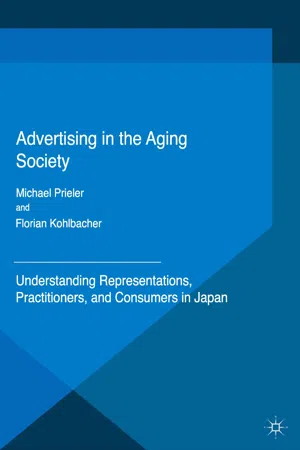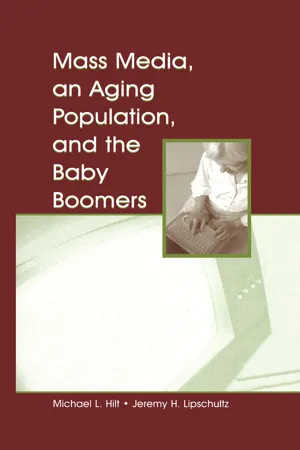Social Sciences
Representation of Age in the Media
The representation of age in the media refers to how different age groups are portrayed and depicted in various forms of media, such as television, film, advertising, and news. This includes examining stereotypes, biases, and the impact of these representations on societal perceptions of aging. It also encompasses the exploration of how older and younger individuals are depicted in terms of roles, characteristics, and behaviors.
Written by Perlego with AI-assistance
Related key terms
3 Key excerpts on "Representation of Age in the Media"
- eBook - ePub
Going Grey
The Mediation of Politics in an Ageing Society
- Scott Davidson(Author)
- 2016(Publication Date)
- Routledge(Publisher)
Chapter 6Ageing in the Media
The age transformation of society should influence the production of news and other media in many ways. It will radically alter the labour market and accordingly patterns of media consumption. It will change the shape and interactions of the family that will further alter patterns of media use. The age composition of audiences at different points over each 24-hour cycle will become more pronounced. It is one of the most important transformations that require reporting and analysis during the course of the current century.As we shall see in this chapter older people are the most avid consumers of news media and the shifting audience demographics suggest any mass media product will need to do well with older audiences to establish leading figures in terms of audience share. With older people representing such a large, and growing, proportion of media consumers, it might be expected that the modern media need to move beyond merely reflecting historical ageist attitudes in society, but instead be at the cutting edge of changing attitudes during the great age transformation. Of course, a realistic prediction must be to anticipate that media content will reflect the continued existence of ageist attitudes alongside attempts to commercially benefit from the growing spending power of the ‘grey pound’. However, there is a problematic dearth of previous research material that specifically investigates media content and societal ageing. Mass communication research has generated a large volume of work on media portrayals of different groups within society. However, studies into the portrayal of older people, or the issues identified as being central to their quality of life, are rare in comparison to research which has focused on youth, the other group thought to be most at risk of social exclusion in terms of their age demographic. - eBook - ePub
Advertising in the Aging Society
Understanding Representations, Practitioners, and Consumers in Japan
- Florian Kohlbacher, Michael Prieler(Authors)
- 2016(Publication Date)
- Palgrave Macmillan(Publisher)
The following overview of existing literature helps situate our results in a more global context. However, comparisons between our research and past studies require caution because earlier research was based upon different cultural contexts, sample sizes and sampling methods (prime time vs. whole day, duplicated vs. unduplicated television advertisements), and varying definitions of “older people” (ranging from age 45 or older to age 65 years or older). The variables we have found most important for analyzing representation of older people in television advertisements are derived and adapted from previous research on social groups focusing on the following areas: age groups in television advertisements, frequency of representation of older people (including by gender), perceived importance, celebrity versus non-celebrity, the image of older people, social interaction, setting, and product categories.Frequency of older people (by gender)Over- or under-representation of social groups in the media is a possible indicator of their importance, relevance, and recognition within society (Gerbner et al., 1980; Signorielli & Bacue, 1999). It can also affect public knowledge and perceptions of these groups as well as the view that society has of these groups (Abrams et al., 2003). For example, young people may come to believe that the number of older people in the population is small (Gerbner et al., 1980). Many previous studies have found that older people were underrepresented in television advertisements compared to the demographic reality (Bai, 2014; Ylänne, 2015). This was demonstrated in articles published in the United States (Atkins, Jenkins, & Perkins, 1990/1991; Greco, 1993; Langmeyer, 1993; M. M. Lee, Carpenter, & Meyers, 2007; Peterson & Ross, 1997; Roy & Harwood, 1997). For example, Gerbner and associates (1980) reported that the underrepresentation of people began somewhat under the age of 50 for prime-time advertisements. Langmeyer (1993) reported that 12.3% of television advertisements featured people age 60 or older, although this group constituted 16.7% of the population. Research defining older people as age 45 or older (Peterson & Ross, 1997), age 50 or older (Atkins et al., 1990/1991), and age 55 or older (M. M. Lee et al., 2007) obtained similar results. The underrepresentation of older people has also been found in other parts of the world, such as Australia (Higgs & Milner, 2006), South Korea (B.-K. Lee et al., 2006; Ong & Chang, 2009), and Germany (Kessler et al., 2010). Lee and associates (2006) reported that older people were represented in 8.0% of advertisements although they constituted 12% of the population in South Korea. Ong and Chang (2009) also found the same underrepresentation in South Korea (8.6% vs. 13.3%) and Malaysia (2.5% vs. 6.6%). However, a few studies have reported results that were closer to demographic reality, such as in China (Y. B. Zhang et al., 2008), the United Kingdom (Simcock & Sudbury, 2006), and the United States (B.-K. Lee et al., 2006). - Michael L. Hilt, Jeremy H. Lipschultz(Authors)
- 2016(Publication Date)
- Routledge(Publisher)
As mentioned in the previous chapter, the older population in the United States is increasing dramatically as healthy Americans have longer lives (Barrow, 1996). Census projections show that, by 2040, the nation could have more people over age 65 than under age 21, and more than one in four Americans will be age 65 or older (Howe & Strauss, 2000, 2003; Usdansky, 1992). This chapter explores previous research on media and older people, and establishes a foundation for interpreting observations about media portrayals, uses, processes, content, effects, and culture as it pertains to people age 50 and older.Intergenerational Communication, Identity, and Families
Research has focused on how people in different generations communicate with one another. There has been a particular interest in how intergenerational communication functions within families. Harwood (2000), for example, studied the degree to which communication between grandparents and grandchildren happened face-to-face, over the telephone, and through written media. Media richness, the theory that certain forms of communication elicit more information, offers one explanation for the nature of intergenerational interaction. Kahai and Cooper (2003), for example, found that richer media forms facilitated positive social perceptions and emotions. Leaner media, such as e-mail, offered more clarity but less in terms of social value. Williams and Nussbaum (2001) summarized that “a rich understanding of intergenerational communication is only made possible by first realizing that all communication takes place within a relational context” (p. 167).Human communication studies on the elderly provide an important foundation for the focus on mass media:The environment of cities, neighborhoods, mass transit, crime, political agendas, governmental policies, and the media portrayal and reporting of all of these factors can create a communication climate difficult for younger and older individuals to master. Prior to any communication shared by the generations, each individual must first battle the real or perceived barriers to a successful communicative encounter. (Williams & Nussbaum, 2001, pp. 260–261)
Learn about this page
Index pages curate the most relevant extracts from our library of academic textbooks. They’ve been created using an in-house natural language model (NLM), each adding context and meaning to key research topics.


